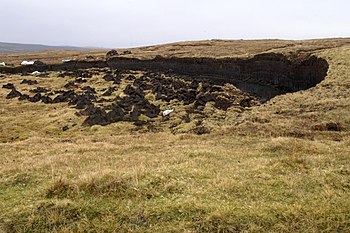
Back مستنقع البطانية Arabic Terrændækkende mose Danish Bratphortach Irish Terrengdekkande myr NN Terrengdekkende myr NB

Blanket bog or blanket mire, also known as featherbed bog, is an area of peatland, forming where there is a climate of high rainfall and a low level of evapotranspiration, allowing peat to develop not only in wet hollows but over large expanses of undulating ground.[1][2] The blanketing of the ground with a variable depth of peat gives the habitat type its name. Blanket bogs are found extensively throughout the northern hemisphere - well-studied examples are found in Ireland and Scotland, but vast areas of North American tundra also qualify as blanket bogs. In Europe, the southernmost edge of range[3] of this habitat has been recently mapped in the Cantabrian Mountains, northern Spain, but the current distribution of blanket bogs globally remains unknown.
In the southern hemisphere they are less well-developed due to the relatively low latitudes of the main land areas, though similar environments are reported in Patagonia,[4] the Falkland Islands and New Zealand.[5] The blanket bogs known as 'featherbeds' on subantarctic Macquarie Island occur on raised marine terraces; they may be up to 5 m (16 ft) deep, tremble or quake when walked on and can be hazardous to cross.[6] It is doubtful whether the extremely impoverished flora of Antarctica is sufficiently well developed to be considered as blanket bogs.
In some areas of Europe, the spread of blanket bogs is traced to deforestation by prehistoric cultures.[7]
- ^ Gorham, E. (1957). The development of peatlands. Quarterly Review of Biology, 32, 145–66.
- ^ Keddy, P.A. (2010). Wetland Ecology: Principles and Conservation (2nd edition). Cambridge University Press, Cambridge, UK.
- ^ Chico et al., (2019). "Identification and classification of unmapped blanket bogs in the Cordillera Cantábrica, northern Spain". Mires and Peat, 24(2), 1-12
- ^ Arroyo, M.T.K., P. Mihoc, P. Pliscoff and M. Arroyo-Kalin. (2005). "The Magellanic moorland". P. 424-445 in L.H. Fraser and P.A. Keddy (eds.). The World's Largest Wetlands: Ecology and Conservation. Cambridge University Press, Cambridge, UK.
- ^ "For Peat's Sake" (PDF). Environment Waikato. June 2006.
- ^ Hince, Bernadette (2000). The Antarctic Dictionary: A Complete Guide to Antarctic English. Melbourne: CSIRO Publishing. p. 126. ISBN 0643102329.
- ^ Moore, P. D. (1973). "The influence of prehistoric cultures upon the initiation and spread of blanket bog in upland Wales". Nature, 241, 350–353.